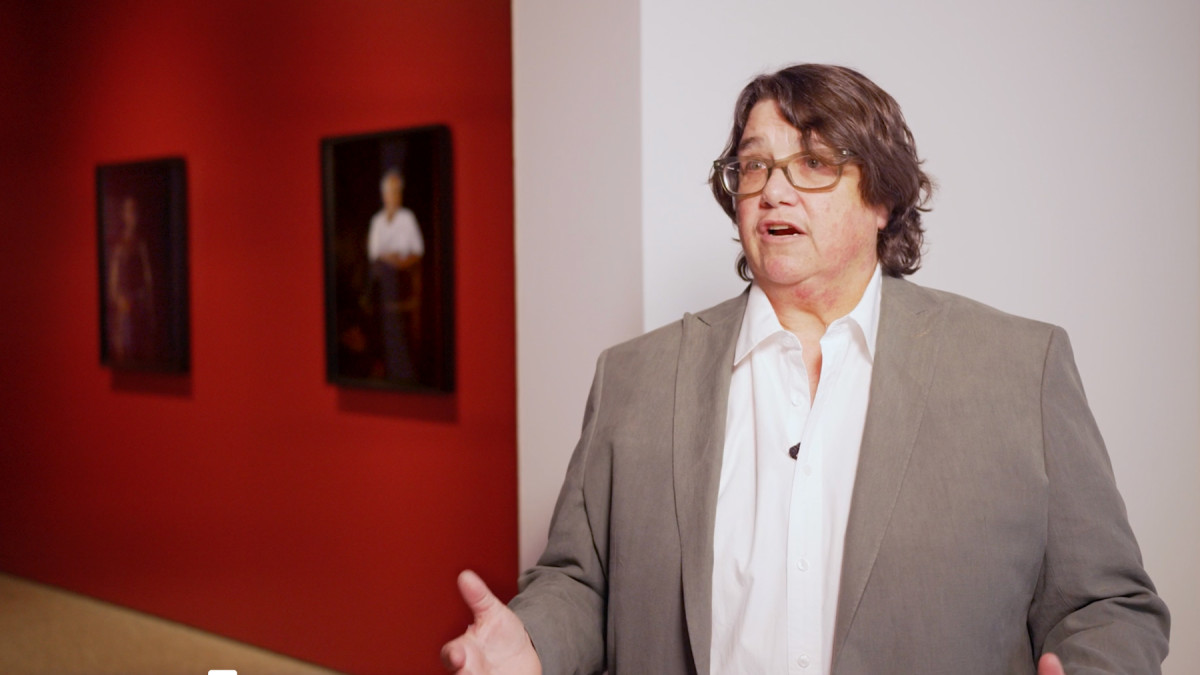Ben Deroy
2007 - Sculpture (Sculpture)
Ben Shaffer
Ben Shaffer’s Ben Deroy (2007) is part performance, part self-portrait, and part spiritual vision. Often the artist works with the motifs of the counterculture and contemporary non-religious spiritualism. The figure hangs suspended—seemingly ascending—animation. The figure looks like some kind of countercultural superman empowered by myriad alternative experiences, as worthy of myth as the heralded Laocoön.
Ben Shaffer’s works are dynamic installations that integrate sculpture, painting, and performance. His complex pieces often require direct interaction from viewers, eschewing simple subject-object relationships in favor of relational negotiations. Through his makeshift neo- psychedelia, Shaffer explores the legacy of counter-cultural imagery, specifically its fragile utopic horizons and ever-receding promises of enlightenment and transcendence. Shaffer lives and works in Los Angeles, and received his MFA from Claremont University in Southern California.
Colors:
Other related works, blended automatically

© » KADIST
Federico Herrero
2009Federico Herrero’s energetic paintings reflect his experiences on the streets of his native San José, Costa Rica, and in the surrounding tropical landscape...

© » KADIST
Scott Reeder
2013Reeder’s works often start with language—and his Pasta Paintings are no different...

© » KADIST
Catherine Opie
1993Like many of Opie’s works, Mike and Sky presents female masculinity to defy a binary understanding of gender...

© » ROYAL ACADEMY
Catherine Opie
Video: Catherine Opie on photographing leading British artists | Blog | Royal Academy of Arts Catherine Opie in the RA Collection Gallery Video: Catherine Opie on photographing leading British artists Read more Become a Friend Video: Catherine Opie on photographing leading British artists Published 8 September 2023 Catherine Opie discusses her portraits of David Hockney, Anish Kapoor, Gillian Wearing, Isaac Julien and Lynette Yiadom-Boakye, featured in our free display in the Collection Gallery...

© » KADIST
Rodney Graham
1996Tree on the Former Site of Camera Obscura (1996) belongs to a series of large-scale photographs of trees taken by Graham and depicts a particular species that lives in Northern California...

© » KADIST
Natasha Wheat
2011Natasha Wheat’s Kerosene Triptych (2011) is composed of three images, one each from the digital files of the Library of Congress, the Smithsonian Institution, and the Field Museum tropical research archive...

© » KADIST
Rodney Graham
1991Ponderosa Pine IV belongs to a series of large-scale photographs of trees taken by Graham and depicts a particular species that live in Northern California...

© » KADIST
Gareth Moore
2006Uncertain Pilgrimage is an ongoing project in which Moore draws from his unplanned travels in recent years...

© » KADIST
Chadwick Rantanen
2010Telescopic Pole is an adjustable telescopic pole that extends vertically from floor to ceiling and is held up by its own internal pressure...

© » KADIST
Yang Guangnan
2011Itch explores the relationship between technology and daily human experience with a motorized arm that extends from within the gallery’s wall, moving up and down while holding a projector that shows a desperately scratching pair of hands....

© » KADIST
James Welling
2006Welling employs simple materials like crumpled aluminum foil, wrinkled fabric and pastry dough and directly exposes them as photograms, playing with the image in the process of revealing it...

© » KADIST
Ian Wallace
2000Untitled (Breathless) presents a folded newspaper article on Jean-Luc Godard’s À Bout de Souffle (Breathless)...

© » KADIST
Geoffrey Farmer
2009Ongoing Time Stabbed with a Dagger was Farmer’s first kinetic sculpture that added a cinematic character to an “ever-reconfiguring play presented in real time.” The assembly of various objects and props on top of a large platform constitutes not only a work, but, to a certain extent, a show in itself...

© » KADIST
Christine Sun Kim
2022Hand Palm Echo 1 is a digital animation based on Christine Sun Kim’s staircase mural at The Drawing Center in New York (10 March – 22 May, 2022)...






